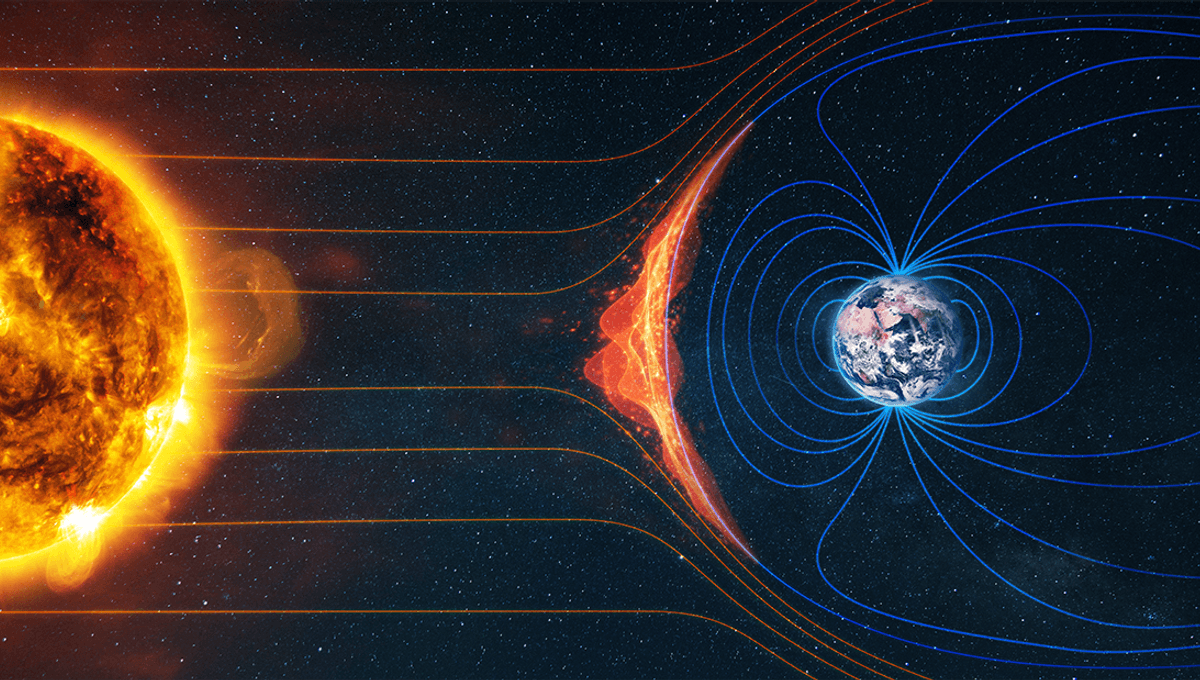
Though you might think that compasses will always point towards the geographic north pole, the magnetic and geographic poles do not always align. As well as a few temporary reversals, the Earth’s magnetic field – just like the Sun – can flip over long timescales. During the Brunhes–Matuyama reversal, the magnetic north could have been as far south as the equator.
You probably don’t worry about the Earth’s magnetic fields too much, assuming you don’t have to rely on a compass for navigation. The magnetosphere generally sits up there minding its own business, protecting the Earth’s surface from charged particles from the Sun, and occasionally producing spectacular aurora. But the Earth’s magnetic fields are not as fixed as you might think.
“We know that over the past 200 years, the magnetic field has weakened about 9 percent on a global average. However, paleomagnetic studies show the field is actually about the strongest it’s been in the past 100,000 years, and is twice as intense as its million-year average,” NASA explains.
“Since it was first precisely located by British Royal Navy officer and polar explorer Sir James Clark Ross in 1831, the magnetic north pole’s position has gradually drifted north-northwest by more than 600 miles (1,100 kilometers), and its forward speed has increased, from about 10 miles (16 kilometers) per year to about 34 miles (55 kilometers) per year.”
The poles can flip over the course of hundreds or thousands of years, and this can happen at random, with intervals ranging anywhere from 10,000 years to 50 million years or more. Around 41,000 years ago, the Earth went through a temporary reversal known as the Laschamp event. By studying the magnetization of sediment cores taken from the time, scientists identified that the magnetic field briefly flipped during this time period.
“The field geometry of reversed polarity, with field lines pointing into the opposite direction when compared to today’s configuration, lasted for only about 440 years, and it was associated with a field strength that was only one quarter of today’s field,” GFZ German Research Centre for Geosciences researcher Norbert Nowaczyk, who studied the event, said in a statement in 2012. “The actual polarity changes lasted only 250 years. In terms of geological time scales, that is very fast.”
While there are claims that the event was linked to the extinction of megafauna in Australia and the extinction of the Neanderthals through resulting changes to the Earth’s climate, experts are skeptical, for example pointing out that these events don’t line up well with temperature evidence from ice cores.
The last true sustained reversal of the magnetic poles happened around 780,000 years ago, and is named the Brunhes–Matuyama reversal after the geophysicists who first found evidence for it. While the Laschamp event was short-lived in geological timescales, the Brunhes–Matuyama reversal is believed to have taken place over longer timescales. Exactly how long the reversal lasted is still subject for scientific debate, with higher estimates suggesting a reversal lasting 22,000 years. Evidence for this reversal can be seen across the world, largely by looking at magnetic field lines in the sediment records.
While you may picture ancient human ancestors looking baffled as their anachronistic compasses suddenly flip direction, these reversals are not so simple, and the magnetic field can weaken to as little as 10 percent of the strength we are used to. During them, there can be magnetic poles as far down as the equator, or even multiple north and south poles at different areas of the planet.
The fields move around as a result of the liquid metal sloshing around inside the Earth’s outer core, themselves at the whims of the motion of the planet and its rotation, as well as heat-driven convection. Though it has been some time since the last true reversal and excursion, the poles continue to move around the planet, and it remains difficult to predict when the next such reversal will occur. Earlier this month, the magnetic north got an updated position.
“The current behaviour of magnetic north is something that we have never observed before,” Dr William Brown, global geomagnetic field modeler at BGS, said in a statement earlier in December. “Magnetic north has been moving slowly around Canada since the 1500s but, in the past 20 years, it accelerated towards Siberia, increasing in speed every year until about five years ago, when it suddenly decelerated from 50 to 35 km per year, which is the biggest deceleration in speed we’ve ever seen.”
Source Link: Brunhes–Matuyama Reversal: When Earth's Magnetic Field Flips